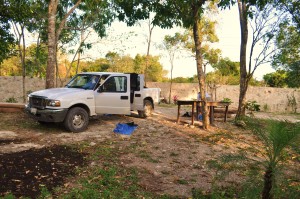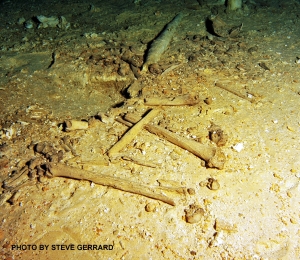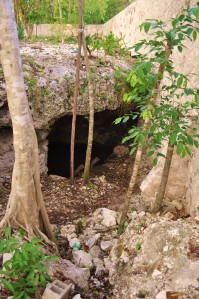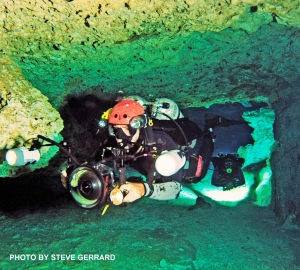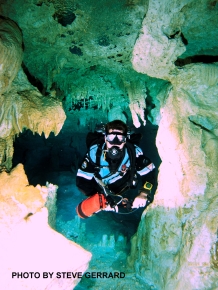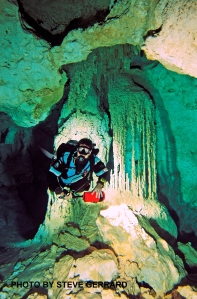Written by Barbara Dwyer
Cenote Chan Hol was first dived and explored by Kim Davidsonn in 2004 as a homework assignment given by Robbie Schmittner. This cenote is a depression located 7 kilometers south of the City of Tulum almost directly on Highway 307 on the west side. Chan Hol means “small hole” as the cave entrance was considered a minor restriction.
In March 2007, Chan Hol was connected Sistema Toh-Ha.
Preliminary dives were difficult.
The silty entry pool measured only about one square meter/10.2 feet. Poking around with Highway 307 had already been “improved,” but much of the land around Tulum remained undeveloped. Yucatán is laced with cenotes, and divers were seeking to make connections. Exploration was underway on a handful of systems, including nearby Sistema Toh Ha.
A sharp-eyed local explorer first sighted the cenote as a clump of low-lying foliage just off the highway south of Tulum. Robbie Schmittner found a silty puddle below an overhang in a collapsed cenote. Busy with explorations and running his dive store, Robbie tabled the lead temporarily. The cenote remained unexplored for a year until he mentioned it to fellow divers Dave Sieff and Kim Davidsson. Kim, afflicted with “exploration fever,” seized the opportunity. “I had been walking around the jungle looking for virgin cenotes,” Kim recalls, and “had already tried to squeeze into some small holes not fit for my experience level or comfort zone. This one was for sure worth a try.” Poking around with a mask and flashlight, Kim found an entrance 20 cm/8” high and about 100 cm/40” wide, with a big tooth-shaped rock obstructing the middle of the passage. “I took a deep breath. Dave held on to my feet, and I ducked under. I reached full body length inside the cave and down sloping gravel. There could be something there, but it quickly got silted out. We need to go back with dive equipment.” On the first full dive, Kim used side mounted tanks and had to wriggle and twist to clear the restriction. But just beyond the entrance ramp lay a sizable room. Ledges and flowstone decorated the wall straight across. Two intact Mayan pots lay close to the entry, and cave passage opened left and right. Kim chose to take the right-hand path (north), hoping for a connection to Sistema Toh Ha (Mayan for Mot Mot Water, referring to a species of tropical bird). He laid about 900’ feet/___ meters of line, calling the passage Xibalba (the underworld, in Mayan cosmology). In the other direction he would subsequently install the main line with its many offshoots, cavernous rooms, and fossil discoveries. For the next two years Kim continued his exploration mostly at night after work.
The exploration paid off immediately, yielding more and more beautiful passage with varied formations. Cenote Chan Hol is reminiscent of the historic portion of Sac Sistema Aktun upstream of Gran Cenote. Small side mount passages and bedding planes contrast with power cave, borehole tunnels, and large rooms with flowstone. There are highly decorated sections featuring spectacular and odd formations. Visibility is crystal clear, with percolation in lightly traveled passages. The average depth is around 33 feet/10 meters. Negligible flow is present. On another dive (2009) Kim connected to Cenote Ba’ab Zooz (Swimming Bats) across the main road. This passage added another 6059 feet/1845 meters and was unlike most other parts of the cave.
The tunnels are dark and narrow and require removal of at least one tank through the side mount restrictions. Brown fluffy “mung” and mud cover the floors and walls.
Percolation is abundant, and one careless fin kick will reduce your visibility to zero. There is no little to no flow here. It’s an easy place to get lost, and divers are discouraged from casual investigation. For that reason, the route is not easily found.
Cenote Chan Hol’s access and diving.
Chan Hol is located just off Highway 307 about 11 km/7 miles south of Tulum. After the “big bend” in the road, look for the “Rancho Loma Linda” sign on the right hand side. Turn right at the end of the driveway and stop in about 50 feet/15.2 meters. Owners Don Domingo and Doña Hermina welcome divers and collect a fee of 200 pesos per diver per day. They ask that divers be out of the water by dark.
Jungle access is no longer necessary. The owners built their home in 2006. To accommodate divers, they provided tables, removed the itch-producing chen chen trees, and built an entry step. There is a baño (toilet) at the rear of the house. Don Domingo proudly shows his property, pointing out the chaca tree (antidote for the chen chen’s effects), his cenote-irrigated vegetable gardens, and his chickens. The owners and diver traffic have enlarged the entry since the early days of exploration. A few years ago, back-mounted entry required turning to the right and considerable wiggling, even for smaller divers. Now, a large diver with bulky back tanks can clear the floor or the ceiling without silting. The floor has suffered some damage, mostly near the cavern, and the occasional hand print or stage bottle damage is visible as far as about 2500-3000 feet/750-900 meters in. The explorers emphasize conservation and request that divers sharpen their buoyancy control before diving here.
From the entrance, the line leads down a gravel-strewn slope to a “T” (with double arrows pointing back to the cavern). The left branch of the “T” leads to the Torpedo line, which is a shortcut through small passage to the main line portion of the cave. The right-hand “Xibalba” branch loops around through big passage with multiple offshoots, eventually re-joining the Torpedo line at a second T with double arrows pointing along the shorter Torpedo route out. From here the mainline gives access to the Forza Room, the Professor loop, and thousands of feet of decorated passage beyond. The shallow nature of this cave allows long and multiple dives to be made in a day.
Pre-Ice Age skeleton discovered in 2006.
German cave divers Alex and Torsten Kampe found a nearly intact skeleton just off the main line about 1500 feet/457.2 meters into the cave. The find included extremity bones, vertebrae, ribs, and skull with several intact teeth. The minimal dental wearing indicated an early death. “El joven de Chan Hol” (the young man of Chan Hol), as scientists dubbed the remains, lived more than 10,000 years ago, before the last Ice Age ended, when Yucatán’s caves were above sea level. The remains’ layout reportedly suggests that the boy was ritually buried. This discovery and others* will provide new data about settlement of the Americas, according to Mexico’s National Institute of Anthropology and History (Instituto Nacional de Antropología e Historia, or INAH). Chan Hol’s “el joven” is one of four such skeletons found in underwater caves near Tulum, with more undoubtedly to come. Its distance from the entrance in addition to previous work done are expected to corroborate radioisotope dating of its age.
Until recently, divers who knew where to look could see these remains. However, the entire skeleton was recovered by INAH investigators for radioisotope dating. We had seen the skeleton previously but last December found only a few bones in a box with INAH’s logo. Alert divers will find other fossils. Some examples, including pottery and intact fire pits, are along the main line and elsewhere. The first pots discovered, along with a monkey’s fossilized skull and some long mammalian bones, have been placed on a ledge just across from the entrance. Cenote Chan Hol remains under exploration, with new passage being found. For a brief time, it was the longest single entrance cave in Mexico until the connection was made to Cenote Toh Ha. The total cave system is 105,036 feet/32015 meters long with a maximum depth of 42 feet/14.9meters. Seventeen cenotes have been reported in the cave system to date. And no one will be surprised if this “small hole” yields yet more going passage.
*Three other human skeletons have been discovered in nearby caves, including Eva de Naharon (Eve of Naharon), La mujer de Las Palmas (Woman of
Las Palmas) and El hombre del Templo (The Man of El Templo). Their ages vary between 10,000 and 14,000 years old. Other finds include tools,fire pits, and remains of animals that date from the Late Pleistocene Age.
References:
- INAH: http://www.inah.gob.mx/index.php/english-press-releases/61-anthropology/62-10000-years-old-skeleton-extracted-from-flooded-cave
- http://news.nationalgeographic.com/news/2011/03/pictures/110309-oldest-skull-americas-underwater-cave-mexico-mastodon-science-first/
- Coke, J. G. IV, Perry E.C., Long

